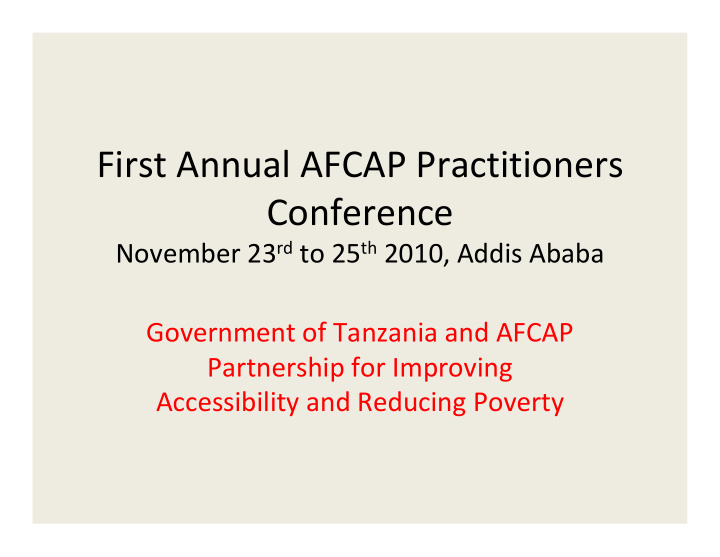



First Annual AFCAP Practitioners Conference November 23 rd to 25 th 2010, Addis Ababa Government of Tanzania and AFCAP Partnership for Improving Accessibility and Reducing Poverty
• The Local Roads are managed Management of Local Roads in Tanzania by the 132 Local Government Authorities . • The Councils carry out planning, prioritization, project design, tendering and supervision of maintenance and development works implemented by contractors. • The Councils also supports the villages/communities in maintaining and improving the Community Road s
Management of Local Roads The Prime Ministers Office Regional Administration and Local Government (PMO-RALG) through its Regional Secretariat offices has an oversight function of: • preparing policies and strategies, • coordination and monitoring of the road activities • provide capacity building and advisory support to the councils.
The National Road Surface Type Km % Network Earth 44,641 76.9 Tanzania Road Network 91,049 km. Gravel 12,606 21.7 TANROADS: Sealed Surface 790 1.4 responsible for Trunk TOTAL 58,037 100.0 and Regional Roads: 33,012 km. Local Government Gravel Sealed 21,7% 1.4% Authorities : responsible for District Roads ( Collector and Feeder): 58,037km. Community roads: Earth 76.9%
Area: Total 945,000 km 2 Population : Estimated at 33 million people (2002); - about 51% are women; and about 46% are under age 15. Poverty : About 50% of the population are living below the poverty line.
Natural Resources Minerals - gold, diamonds, tanzanite and various other gemstones, natural gas, iron ore, coal, spring water, phosphates, soda ash and salt. Wildlife and Tourism - 12 National Parks, the Ngorongoro conservation Area, 13 Game reserves, 38 Game Controlled Areas: National Cultural Heritage Sites (about 120 sites) Fisheries - three large lakes: Victoria, Tanganyika and Nyasa, the Indian Ocean coastline, rivers and wetlands.. Forestry and Beekeeping Non-reserved forest-land (1,903.8 km 2 ), Agriculture – in which 80% of the population is engaged has been, and will continue to be the backbone of the country through agricultural transformation.
Challenges • Vast rural roads network with limited financial resources. • Inadequate qualified supervision staff and equipment at district level. • Unequal distribution of locally available construction materials. • Lack of innovation • Inadequacy of essential plant and equipment for road works especially for LVS-roads.
• Local roads provide access for rural communities which is the Government of Tanzania and AFCAP Partnership intended beneficiaries of AFCAP PMO-RALG is the institutional • host of AFCAP activities in Tanzania. • A Steering Group for AFCAP activities has been identified from government institutions and stakeholders within the transport secto r.
Sustainable Access to Reduce Poverty Appropriate Standards All-weather access Manageable Maintenance Low transport costs Appropriate surface Create employment Improve markets, health, education, welfare Local equipment /tools Appropriate techniques Use Local materials Reduce Poverty Use local enterprises
To close the knowledge gap for Improving Accessibility and reduce Poverty the following support were identified: Support the Design, • All-weather access Construction and Monitoring of Demonstration Sites for District Road Improvement; Development of Improved Manageable Maintenance • Maintenance Systems for District Roads; and • Mainstreaming of Low Volume Sealed Roads
Demonstration Sites for District Road Improvement- The Objectives : • To build district level capacity to undertake durable and cost- effective improvements to district roads using local resource based solutions. • Knowledge from the demonstration sites, the D esign Guidelines and Technical Specifications will be disseminated and used by the local authorities
Improved Maintenance Systems for District Roads • Presently the districts are carrying out maintenance of roads using local contractors on short term contracts durations between one and four months for all types of maintenance i.e. routine, spot improvements and periodic • The shortcomings of the present system is that there is no continuous routine maintenance on the most of the roads.
Mainstreaming of Low Volume Sealed Roads • In spite o the obvious need for LVSR in Tanzania, this is not yet being implemented on a national scale due to financial constraints. • The Tanzanian Road Fund Board supports LVSR to be mainstreamed in the annual work plans of the road agencies
Importance of Low Volume Roads • Represent a significant proportion of the road network in Tanzania for which funds are severely limited • Approximately 99% of classified district network is unpaved, occurs in rural areas and is in poor condition • Impact significantly on the livelihoods of the majority of the population who live and work in rural areas • Generally provide the only form of access to rural communities and provide for their mobility • Essential for improving rural livelihoods and socio- economic growth, development and reducing poverty
Conclusion The provision of LVSRs is • influenced by a number of complex and interacting environments in whish non- technical factors play a crucial role. Political and public perception has a tendency to favour conventional approaches and standards with apparent minimum risk attached to them. Therefore the process of • Mainstreaming Low Volume Sealed Roads requires persistence from the key institutions over a long period of time.
Closing the Knowledge Gap Mainstreaming proven research into practice and implementation • to reduce transport costs and poverty. In order to complement poverty reduction strategies, rural • transport and rural access needs must be an integral part of rural development interventions from other sectors. Appropriate Technology, standards and techniques are crucial for • rehabilitation and sustainable maintenance of rural roads. Challenges persists to improve the communities mobility through • access to transport services, IMTs and private sector enterprises and regulations. Promotion of using local resource based methods and locally • available construction materials should be emphasised. Needs for sustainable research on both, road infrastructure • development and transport. (possibly with establishment of responsible institution)
Thank You, Asante Sana
Recommend
More recommend